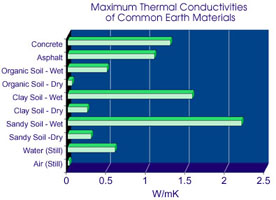Specific heat is the amount of energy required to raise the temperature of one gram of a substance 1 °C. Water has a specific heat of 1.0l the highest for any known substance. Concrete has a specific heat of 0.2; 5 times less than water |
The figure below shows the thermal conductivities of some common materials. The thermal conductivity of materials is usually expressed in watts divided by meter multiplied by the Kelvin temperature (W/mK).
 From this chart it can be seen that dry impervious surfaces (such as concrete/asphalt) have significantly higher thermal conductivity than dry soil. More specifically, concrete/asphalt has about 4-5 times the thermal conductivity of dry soils. Thus, if you take a given landscape composed of dry soils and pave over 20-25% of the surface area within that landscape, you will have effectively doubled the thermal conductivity of that landscape. Note finally that wet soils have the highest thermal conductivity but remember it is the direct combination of specific heat and thermal conductivity that matters. Water has very high specific heat and therefore requires a great deal of incident energy to raise its tempearture. This is the reason why the urban heat island phenomena is maximized in dry conditions. If everything is wet, there is little of a UHI effect. |